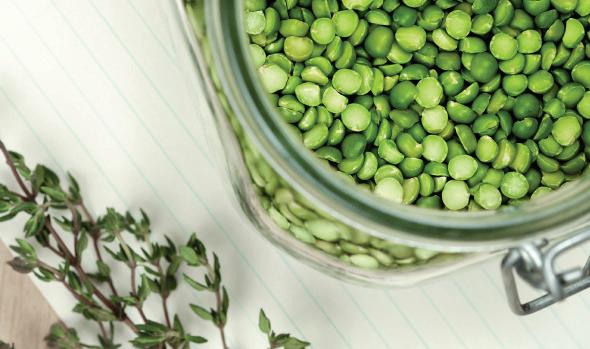
3 minute read
Split Peas
INTRODUCTION
Dried peas, also known as pulses, are nutrition packed. Pulses are the dried seed from a plant grown from the legume family. Dried peas have been consumed since prehistoric times with the remains of peas being found at fossilized archeological sites. Th e cultivation of dried peas dates back to 2,000 BC where they were consumed by the Chinese. Modern day split peas are thought to have originated from the fi eld pea, native to Europe and Asia. Dried peas were introduced to the Americas with the early colonists.
Dried peas are a starchy, hardy legume available year round. Dried peas are harvested from a fully mature peapod that has been dried. When the skin of the dried pea is removed, the seed splits.
QUALITY & PURCHASE
Two varieties of dried peas are available, green and yellow. Yellow peas have a milder fl avor than green peas which are richer and stronger.
Dried peas can be purchased as split or whole in prepackaged bags as well as in bulk containers. Choose peas that are free of cracks and debris.
STORAGE CONDITIONS & SHELF LIFE
Dried peas that are stored in the plastic bags they were purchased in will have a shelf life of only about 1 year. But if properly stored in an airtight sealed container with oxygen absorbers, the shelf-life can be extended to 20 years or more. Dried peas need to be stored in cool, dark conditions to prevent them from losing their yellow and green colors and turning a light gray.


NUTRITION
Dried peas, like other legumes, are rich in soluble fi ber and insoluble fi ber. Soluble fi ber forms a gel-like substance in the digestive tract that binds bile (which contains cholesterol) and carries it out of the body. Dried peas are a very good source of cholesterol-lowering soluble fi ber (Bazzano et al., 2003).
Research studies have shown that insoluble fi ber not only helps to increase stool bulk and prevent constipation, but also helps prevent digestive disorders like irritable bowel syndrome and diverticulitis (Liu, 2004). A single cup of cooked dried peas provides 65 percent of the daily value for fi ber.
ALLERGIES: Not only can dried peas help lower cholesterol, they are also of special benefi t in managing bloodsugar disorders since their high fi ber content prevents blood sugar levels from rising rapidly aft er a meal (McIntosh and Miller, 2001).
Energy Carbohydrates Sugars Fat Protein Folate Dietary Fiber 376 kcal 21 g 8 g 1 g 8 g 94.3 mcg 7 g
Percentages are relative to U.S. recommendations for adults. Nutrient data for this listing was provided by USDA SR-21. Nutrition Data. Available at: http://nutritiondata.self.com/facts/ legumes-and-legume products/4439/2#ixzz2RW9oJQSc
Before using dried split peas, inspect and remove any debris or dirt. Split peas will not need to be presoaked like other dry legumes. Simply put peas into the soup or stew you are making and they will cook in a reasonable amount of time. To prepare split peas that are not part of a soup or stew, place the legumes in a saucepan using 3 cups of fresh water for each cup of peas. Bring to a boil, then reduce to a simmer and cover. Usually split peas only take about 30 minutes to cook. Foam may form during the fi rst 15 minutes of cooking. It can simply be skimmed off .
Split peas may also be ground into pea fl our to use as the basis for some pea soup recipes. Th is allows the peas to cook faster and will thicken the soup as it cooks. Peas are an excellent protein substitute for egg products.









